
Wednesday, July 7, 2010
Dassault

Friday, July 2, 2010
Phillips Global Headquarters- Amsterdam
 On Tuesday May 25th, the group visited the global headquarters of Phillips. The company was originally founded in Amsterdam in 1891 and today employees over 116,000 people. At the start of our visit we were greeted by Nancy Work who escorted us to a conference room where lunch was waiting for us. This was great news for me as I was extremely hungry after a long night out the prior evening and missing breakfast before check-out ;-)
On Tuesday May 25th, the group visited the global headquarters of Phillips. The company was originally founded in Amsterdam in 1891 and today employees over 116,000 people. At the start of our visit we were greeted by Nancy Work who escorted us to a conference room where lunch was waiting for us. This was great news for me as I was extremely hungry after a long night out the prior evening and missing breakfast before check-out ;-)The meeting was spread out over 4 hours with presentations from four individuals. The company overall makes a big effort to promote healthy living and specializes in energy efficient consumer goods. They have three areas of focus, including Healthcare, Lighting, and Consumer Electronics.
The brand is based around "Sense and Simplicity" and much of what they showed us lived up to this motto. Several products were discussed and more than a few caught my attention.
Probably one of their more well know products are their LED lightbulbs. These bulbs run on just 10 watts and last 25 times longer than the old 60 watt incandescant bulbs. Just by purchasing their lightbulbs and installing them in your home you get a sense that you are doing your part to conserve energy.
Two other products really stuck out for me that day. The first was a concept for a new street light that generated its own energy by solar power and wind power. The design was to resemble a flower that could open or close based on if it was in use or producing energy. This i san idea that I think could really gain some traction as elected officials around the globe look to cut costs for things that are more or less essential to the infrastructure of our cities.
The second product that stuck out for me was the concept of a solar "alarm" clock. Instead of waking to an annoying alarm, it is designed to simulate the rise of the sun and the light itself woudl gently wake you up in the morning. That sounds very interesting and I have even found it on their website for $169.99. Check it out!
We also had some interesting discussion about lighting of stadiums and new LED ambient lighting that is being used on the tops of buildings and public spaces to really change the dynamics of skylines. In fact, it was revealed that the Prudential Tower in Boston is actually one of their clients and they are working on new lighting options for the top of that building.
Overall, our trip to Phillips was highly informatitive, very interesting, and well worth the trip!
Tuesday, June 22, 2010
ESSCA
 Upon arrival, we are greeted by Mr. Albrecht Sonntag, professor of Int’l Business at ESSCA, who has graciously offered to discuss issues concerning the European Union. Daunting as the topic may seem, I prepared myself (diet coke in hand) to focus on the presentation in progress. Mr. Sonntag’s strong grasp of the subject, perfect English and excellent presentation skills kept us intrigued and alert.
Upon arrival, we are greeted by Mr. Albrecht Sonntag, professor of Int’l Business at ESSCA, who has graciously offered to discuss issues concerning the European Union. Daunting as the topic may seem, I prepared myself (diet coke in hand) to focus on the presentation in progress. Mr. Sonntag’s strong grasp of the subject, perfect English and excellent presentation skills kept us intrigued and alert. We discussed topics such as the effects of cultural integration, the impact of the crisis, the future
 of the EU, the role of leadership, federalism, the Lisbon Treaty and shared sovereignty, to name a few. I was amazed to learn about how Europe’s history and collective desire to band together evolved to what we now know as the European Union. This unique structure and entity differs from any other type of governing body in the world and continues to change and progress. Professor Brunel’s passion and advocacy for the Commission sparked a lively debate regarding the validity of elected and appointed officials as well as the public’s role in shaping the union. We concluded that due to human nature, the public generally supports the “idea” of the EU, but not the actual “realization” of what full integration entails.
of the EU, the role of leadership, federalism, the Lisbon Treaty and shared sovereignty, to name a few. I was amazed to learn about how Europe’s history and collective desire to band together evolved to what we now know as the European Union. This unique structure and entity differs from any other type of governing body in the world and continues to change and progress. Professor Brunel’s passion and advocacy for the Commission sparked a lively debate regarding the validity of elected and appointed officials as well as the public’s role in shaping the union. We concluded that due to human nature, the public generally supports the “idea” of the EU, but not the actual “realization” of what full integration entails.The million-dollar question of the day was “Is Europe in a crisis?” Contrary to what we all may have assumed, Mr. Sonntag responds with a resounding, “YES, Europe has been in a continuous and permanent crisis because they have come to no resolution as of this day. Europe’s direction demonstrates a strong step towards federalism, as proven by the euro, but also a strong opposition to coordination on fiscal and economic policy.” Although this hybrid entity has proven successful in the past, the impact of the economic crisis and any other future catastrophes leads us to question the EU’s future sustainability.
The future of the European Union is still unknown. Perhaps we will see increased control over the Euro budget, amplified pressure by nation states on tighter economic governance, or the withdrawal of certain nation states. We will have to wait and see...

On a side note: It is the 10th anniversary of the European Field Seminar and we should all congratulate Prof. Brunel for giving us this unique and exciting experience! Santé!!!
Friday, June 18, 2010
Peclers Paris..."fashioning the future"
On Tuesday, June 
We met with Ms. Emma Fric, Global Development Director. Ms. Fric informed us that in the late 1960s, large-scale manufacturing of fashion and design products allowed for the replacement of haute-couture production methods and commenced the ready-to-wear industry. As a result of this emerging market, Dominique Peclers launched Peclers Paris as a consulting agency for the fashion industry, home and decoration retailers in 1970. By 1980, Peclers realized it had paved the way for trend publication based on its use of historical trends to decipher and anticipate future trend direction. A huge hurdle for Peclers is predicting consumer behavior, anticipating future attitudes and imagining future aesthetic preferences. Interestingly, Peclers employs no focus groups and instead relies upon research teams that recognize innovation and know emerging areas. These teams frequently travel to access and formulate new trends, as well as research and strategize the industries and clients they want to advise.
While some brands request exclusivity, other clients realize fashion trending is a global enterprise in which trends are not created in a vacuum. Fashion trends often encounter a 2-year-forecasting-to-market timeline, whereas architecture (10-year timeline) and cosmetics (5-10-year timeline) take longer to emerge in the marketplace. A recent trend is the myriad of interplaying contexts in nature due to the introduction of sustainability. Peclers is utilizing this trend in an effort to appeal to emotions and issues surrounding over-consumption.
Today, Peclers garners 55% of its revenue from consulting and 45% from trend and forecasting publications. Ms. Fric told us that some trends are cyclical and consumer thoughts tend to come back around to people and profiles in different global areas. Out of the 18 trend books produced by Peclers, "Futur(s)," utilizes global analysis to understand evolving values and future consumer behaviors. The 10th, and most recent, edition of "Futur(s)" is printed in both French and English and retails for approximately 5,000€.
Although the global economy has affected sales of Peclers' trend books, we were told the fashion industry will not stand still. Trends will revamp and reintroduce themselves to the global market and consumer purchasing behavior, though different from before, will still require agencies like Peclers to aid brands in deciding what to produce for which markets.
Thursday, June 17, 2010
Wednesday, June 16, 2010
Business Objects - Friday, May 28th





Audi- on June 4, 2010
We arrived Audi around 12.30 after visiting Lear Corporation. The distance between Lear and Audi is not far at all, helping JIT to be more efficient and practical. The size of this factory is very large. If I'm not wrong, Audi is the second biggest company or the biggest engine plant in Hungary. We were presented by financial director whose dress was very cool and looked like a car racing guy, with red PUMA shoes =)
In this presentation, we learned about the history of Audi and obtained some key figures such as revenues, productions, staffs number in 2009 and 2008. Also, he presented us specifically the facts about the factory in Gyor. Audi Gyor produced engines and mainly 3 car models such as TT Coupe and TT Roaster with the daily capacity of 6,900 engines and 300 units respectively. However, net sales and investment in 2009 had decreased due to the economic crisis, therefore, they tried to increase efficiency through current employees. Their vision is to try to “Become quality/flexible/highly focus on being productive. Also, they apply lean operation as Toyota. Their strategy is to focus on four main areas: Profitability, Customer attraction/Customer Focus, Growth, and Most attractive employees.
After the presentation, we went to the factory’s dining hall and found out that Sodexo was the caterer of food for Audi- What a coincidence! I really loved the food here but sadly I forgot to take photos of this meal but I still remembered the taste of chicken pasta- so yummy . Then we went out for a walk to see the oldies sport car rally…All the cars were so cool!!, which I think they are hardly seen somewhere else. The mini BMW is so cute and funny, the owners were very friendly and welcomed us to take photos.
Lastly, the most exciting part of the day came- Assembly line tour!! but we were not allowed to take the pictures inside...I remembered I was very sleepy after a full meal but after walking and see the lines, especially for the car assembly, it’s very spectacular to see how each component were put together in both manually and robot in sequence. I’m also impressed with the facilities inside but most of the work here is done manually instead of robots due to cheaper labor costs, whereas, other factories focus more on robots. Finally, company visits of this trip ended here!!- It was the perfect end of the journey. I feel like I fall in love with Audi TT now and want to get one for myself but how many years do I have to work to get it then- hahaha
Monday, June 14, 2010
Foreign Investments in Hungary - 2nd June

After a long last day in Paris, we arrived to our hotel in Budapest on Tuesday June 1st around 10:30 pm. The Budapest Marriot was probably the best hotel in our trip.
Our first stop in Budapest was the Hungarian Investment & Trade Development (ITD) agency. The ITD is a government body set-up to encourage foreign investment in Hungary.
Brief overview of Hungary: Hungary is a small country with a population of only 10 M people. The financial crisis had a strong impact on Hungarian economy resulting in a negative GDP growth in 2009. We were told that Hungary expects a positive 0.6% growth in 2010. Being in the eastern part of Europe, the average wages are much less than in those cities we visited before. Average wages here are about 700 Euros per month and unemployment is currently high at 10.5%. Lastly, Hungary is not in the Euro Zone and their currency is called the Florent (HUF). We all certainly had a tough time trying to figure out the value of goods in dollar terms. However, Hungary would like to enter the Euro Zone but does not meet the inflation criteria and the debt-to-GDP ratio.
New Government: Since we were visiting a government agency, we all felt a strong pro-Hungarian outlook during the entire presentation. It was a bit ironic when we visited ESSCA during our last meeting in Budapest where we were informed about the poor economic condition of Hungary. ITD has very high hopes of the new government and some of the goals of this government were to create new jobs, focus on SMEs, and attract investments in the financial services, R&D, and manufacturing industries.
Rationale for FDI: Some of the reasons highlighted in the presentation were:
- Higher Education – 90% of students speak English
- # of patents per capita is highest in the region
- Industrial parks encourage growth of foreign companies
- Low corporate tax rate
- High quality of life as compared to some developing Asian countries
- Strong presence of major US companies including GE, IBM, Morgan Stanley, CitiBank etc
- Investment schemes, EU-regulated cash subsidies, & tax allowances from ITD
ITD markets itself as a one-stop shop agency for FDI in Hungary. The main services of ITD are to:
- Help foreign companies in the decision making process including finding locations, finding suppliers etc
- Help during implementation of plan
- Help in the operation phase of the company

The speaker also spoke about the strong automotive & the electronic sector and briefly touched upon the recent Daimler Mercedes investment in Hungary. So our first meeting in Budapest was a typical, very optimistic government agency trying to convince us of the benefits of FDI in Hungary. It was a good start for subsequent discussions in Budapest as we were better informed about the trends & rationale of FDI in Hungary.
We then did a small city tour before heading to our next meeting at EGIS PLC - a pharma company.
Sunday, June 13, 2010
L'Oreal Paris


Sadly, our trip to Paris was almost over. But the day before we left, we spent Memorial Day meeting with Mr. Georges-Edouard Dias and Ms. Marelina Kakiris at L’Oreal Paris. After a long journey to the outskirts of Paris, we arrived at L’Oreal at 12:30, just in time for lunch! We were escorted into a huge and very posh dining room where we were served a three course lunch, topped off with as much wine as we could drink! The first course was a green salad served with smoked salmon, the second course was a delicious plate of pork covered with a creamy sauce, served with roasted mushrooms and some sort of side of potato. But, the best part of our lunch—and I think we can all agree—was the dessert. For dessert, we had a fruit tart covered with strawberry sauce and coupled coffee. During lunch, we had the rare opportunity to talk openly with Georges-Edouard and Marelina about L’Oreals’s global marketing strategy and the future of the company.
And now down to business. After lunch, we went upstairs to a conference room where Georges-Edouard gave us a wonderful, interactive presentation titled Rebooting Marketing—A Digital Transformation. In the presentation we learned that L’Oreal is the #1 Cosmetics group in the world with an unequalled brand portfolio, they had 17.5B in Euro sales last year, they have 61,000 employees world-wide, they spent 53.3M Euro in Research and Development last year, and they offer consumers 25 global brands. Georges-Edouard said that “digital is a powerful force for change” and predicted that there will be 2 Billion people online in 2013. This is a huge potential consumer base that L’Oreal is working to target! L’Oreal feels that they need to find a new and different way to advertise to their customers because traditional newspaper and magazine ads are being phased out while TV and Internet ads are becoming more popular.
Because of the increasing popularity of social media amongst young people, L’Oreal has started creating targeted messages in order to find a brand digital footprint. The goal of the brand digital footprint is to make the customer fall in love and stay in love with the brand. Ultimately, these targeted messages will be a conversation platform where the brand engages with the customer to create lifelong loyalty. Georges-Edouard also spoke about branded entertainment as a new form of advertising. An example of branded entertainment would be to strategically place L’Oreal brands in popular movies and TV shows such as Sex and the City where the target consumers will be sure to see the images. L’Oreal has already started doing this with Garnier, one of their brands. The style and design show Project Runway on Bravo features L’Oreal Paris makeup and Garnier hair products and stylists for the models before they walk the runway. It is interesting that because of different national regulations, this type of advertising is totally acceptable in the United States, but is not allowed in any EU country because of a law against placing products in TV and film.
Georges-Edouard also spoke about L’Oreal’s campaign to start targeting a new population of potential consumers in Africa. He said that since many people in Africa are not online, L’Oreal needed to create a new niche for their brands in Africa. So, their goal is to piggyback on the fact that most Africans either have their own cell phone or share one with a few people in their villages. Many Africans also do some of their necessity shopping on their phones since it is dangerous to carry cash with them on the streets. L’Oreal hopes to eventually “create an economy based on a payment system” that will allow “digital to be the enabler of development”. This fascinated me because I never thought about how different each and every country in the world really is. You can’t come up with one marketing/advertising campaign that can be applied successfully to every culture in the world. L’Oreal is using their creativity to bridge the gap between these different cultures which explains why they are the number one cosmetics company in the world.
Saturday, June 5, 2010
The Last Day...
After our speaker we broke for lunch, there was a market that as nearby they had many different types of food on the ground floor and then some interesting crafts on the second floor. The most interesting thing I saw was this puzzle jewelery box. After our lunch we came back and did a wrap up discussion and our views of Europe and the future of Europe. This discussion found that many of us had the same points come across, however there were some points that we each saw differently.
As this was the last day for some of us many of us went and explored the city a bit, and then we came back together to enjoy our last meal together. It was a fantastic meal at a Michelin Rated 1 Star restaurant. We continued to a Club and some of us returned to the hotel. As some were joined by loved ones in Budapest, others had to leave the next day. I'm sure though that all of us enjoyed our time on this seminar and learned many things.
Sunday, May 30, 2010
Amgen
Background on Amgen
Amgen is a leading biotechnology company that was founded in 1980. EPOGen was one of the first durgs the company produced in 1983, it is used to treat anemia by increasing the production of red blood cells. The company has eight products on the market (Prolia is the ninth) and has been very successful. The challenges that Amgen faces are as follows:
- extremely high R&D costs, it takes between $600 million and $1 billion to bring a new drug to the market (this includes the cost of failed drugs).
- the drugs that Amgen manufactures are large molecules which are complex, unstable and can be difficult to duplicate (this means that good manufacturing practices are very important to be able to replicate the product).
- 90% of projects never reach the market.
- strategic location selection for conducting clinical trials.
- threat of generic brands entering the market.
French Health Care System
France has a social security system which includes retirement, unemployment and healthcare. The system was created in 1946, however it has amounted to a deficit of approximately 9 billion euro. Despite the deficit, Ms. Debiais believes the coverage provided by the French government is wonderful. The care is free and the outcomes are very good in comparison with other countries. Aside from the debt, the other draw back is that this system does not provide much preventative care, however she believes it is still very efficient. Coverage seemlessly continues within the EU member states when traveling.
This part of the discussion led to interesting questions about the care within the US. Based on Ms. Debiais' slides, France spent ~ 10% of GDP on healthcare in 2003, while the US spent ~ 15%. How can the percentage of spending be so large when the quality of care in the US is not as efficient? Has the recent healthcare reform really changed the system or is it just contributing to a higher percentage spent on healthcare? One side of the argument is that universal coverage in the US did not address the issue at hand which is how to fix the major inefficiencies within the healthcare system. What is the role of insurance companies and how can a single payer help the system?
Drug Pricing
The EU law prohibits direct to consumer marketing for prescription drugs and does a good job controlling this issue. The over all price of drugs is much lower in the EU than in the US because of the way the healthcare system is set up. In France the price is very transparent.
Unfortunately we ran out of time and were unable to obtain more detail on the pricing.
Thursday, May 27, 2010
The European Commission
Our first meeting was with a Dusan Sandor, a Slovak diplomat living in Brussels. Dusan explained the functional role of each EU institution. He also spoke briefly about the EU's founding fathers, and his belief that in the future they will be well-known historical figures in Europe, much like Thomas Jefferson or George Washington in the U.S.
Some of the most interesting insights Dusan provided were about how the balance of power has shifted since the founding of the EU. In the beginning, he explained, the council was significantly more powerful than the parliament or commission but the other two gradually gained influence and now their is a much more equitable balance.
Finally, Dusan illustrated how much of an impact the EU presence has had on the city of Brussels, citing statistics such as 25,000 EU employees in Brussels (plus their families) and 10-30,000 lobbyists at any given time.
Our second dpeaker, an Austrian, specialized in EU / U.S. trade relations. She presented some fascinating examples of how closely integrated and interdependent our economies are. For example, she pointed out that the two economies absorb 20% of eachothers product exports and 30% of eachothers service exports. With this in mind, she illustrated the difficulties that regulatory difference between the Eu and U.S. create, and why it is important for us to work cooperatively to establish standardized regulations for future products. She also explained how greater cooperation will help keep our trade relationships as dominant forces, as we face greater competition from the emerging BRIC nations. Towards the end of the discussion we touched briefly on the WTO's interaction with the EU, and professor Brunal added the valuable insight that the EU member states are represented by one common voice in their interactions with the WTO.
Our final speaker was an expert in EU competition policy. He explained how the focus of his organization has shifted from legal competencies to more economic ones. His particular specialization is in anti-trust and merger controls and the extent of penalties that the EU can impose on firms (including fines and behavioral mandates, but no criminal charges). As part of this discussion, Professor Brunel astoutely observed that the fines imposed by the EU can be monumental even when compared with the total EU budget (of which they make up 2-3%.
We certainly learned a lot before getting on the bus to Paris, and the long ride allowed us to continue our discussion on the successes and challenges of the Commission and EU as a whole. Professor Brunel was nice enough to entertain our many questions and provide detailed answers.
Wednesday, May 26, 2010
"Lobbying" in the EU
 This is quite an interesting topic to me because we never have this concept in Taiwan. Sometimes trying to persuade or to cooperate politicians to pass regulations in favor of one’s interests would be treated as dirty or not ethical. As Mr. Turner mentioned, lobbying is regulated and often seen in the US and UK, but not in any other counties, including those EU Member States, which makes lobbying a new merging concept in EU.
This is quite an interesting topic to me because we never have this concept in Taiwan. Sometimes trying to persuade or to cooperate politicians to pass regulations in favor of one’s interests would be treated as dirty or not ethical. As Mr. Turner mentioned, lobbying is regulated and often seen in the US and UK, but not in any other counties, including those EU Member States, which makes lobbying a new merging concept in EU.1. to protect the company’s license or bottom line to operate.
2. to ensure fair competition across markets.
or, offensively,
3. to improve corporate image and/or pre-empt regulatory action
4. to create the perfect regulatory environment for a product or a service.
As a British Politician said,
“If I enact a piece of act that has negative effect to your business and I don’t know, that’s not my fault, it’s yours.”
And considering the size of the EU market and the power of the regulation, it is quite important for companies to pay attention and even actively participate the lobbying activities.
The presentation was going smooth with vivid examples and great discussions between classmates and speakers. One good thing about this trip is that you get to see different topics “on-site”, so I believe I had quite a good lesson today. :)
Atomium and Mini-Europe


Today is Wednesday, May 26, 2010. Our destination in the morning was Atomium and Mini-Europe. Atomium, one of the landmark in Belgium, was built for the Brussels World Expo in 1958. It symbolizes an iron crystal, magnified 165 billion times. The nine large spheres, connected by 20 tubes, are supported by three enormous pillars and dominate with a height of 102 metres the entire Heysel plateau. Nowadays, Atomium still houses for both a permanent exhibition dedicated to Expo 58 and any temporary exhibitions. For Mini-Europe, it is located next to the Atomium, within 5 minutes walk. Mini-Europe is a park filled with tourist attraction models of EU, building down to the finest detail to a scale of 1:25 and zoning by countries.
The day started at 9.30 and we arrived Atomium around 10 am. I was impressed with its shape when taking a closer look to the building and seeing that glass windows look so blending to the sphere. We began our exploration by taking the elevator to the top floor. In the elevator, if we look at the top, we can see the naked structure of the building, which is very fascinating. The view over the top floor was so nice and we could see the 360 angel of Brussels but sadly, we didn’t get the clear blue sky. Then, we got down to the same the ground floor and took the long and steep escalator to another sphere, which is hosted for the “Be welcome” Exhibition, showing about the immigration to Belgium. The show is pretty interesting. It’s funny that I even saw one story of the Thai immigrant, who came and opened Thai restaurant in Brussels. In shorts, we took a lot of photos and had a good time together there.
After spending enough time at Atomium, we all walked to Mini-Europe among rain, why did it have to be this time?, I kept questioning to myself why not in the afternoon :P...Anyway, once after we got in, we as a group took a photo together with the orange turtle holding EU flag. The first model we walked pass by was the EU building, it’s very modern and huge but what I like most there is the Grand Place, the old central square of the Brussels, because it looks so delicate and very similar to what we saw during city walk last night. Everyone had a great time there, taking a photo, despite the rain!. At the same time, Prof. Brunel did a good job being our tour guide leader, explaining and identifying us the outstanding places in Europe. This walk amazed me in the way that there are some countries or places in Europe that I never heard of the name before. Once I watched the time again, it was almost 12.00 pm!, and we had to head back to the city and have lunch before our first meeting of the day. Bye Bye Relaxing time, see you again soon after 6!!
A day in Brussels
So far on the 2 days since we've started this journey of ours through the companies and countries of Europe we start off with the breakfast of the hotel. Today we got a bit of break compared to yesterday in that we were able to sleep in, and didn't have our first meetings with the companies of the day until the afternoon. If only the weather cooperated and allowed us to enjoy Belgium with the little time we have (tomorrow we depart for Paris after our visit to the European Council).
So in the pouring rain we went to the Atomium, and Mini-Europe. The Atomium is the free-standing structure that was built for the 1958 Brussels World Expo (World's Fair) similar to that of the Eiffel Tower which was built for the 1889 World Expo. The Atomium was modeled after a molecule of Iron Crystal and is quite a site to see, and fairly massive.
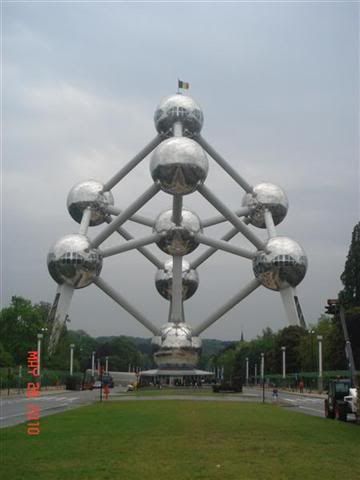
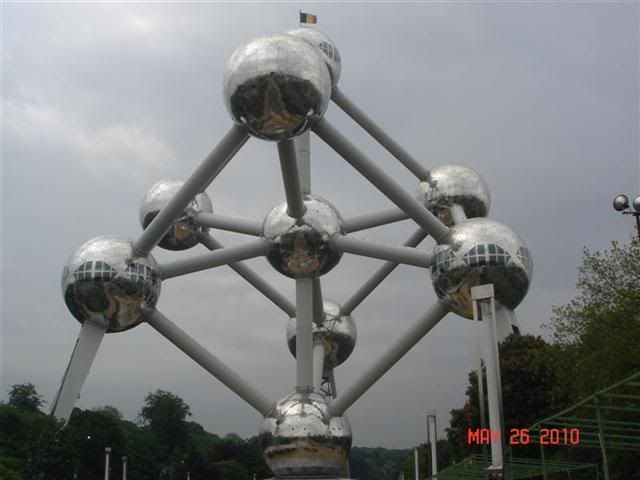
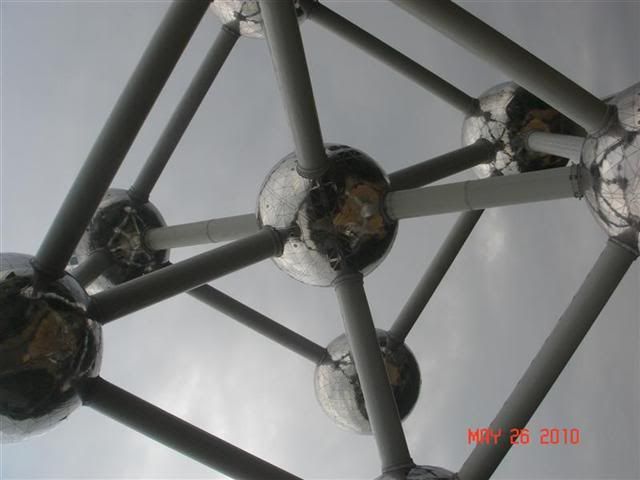
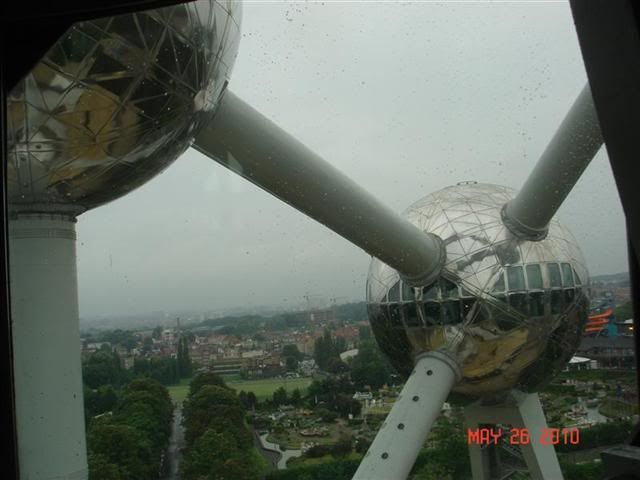
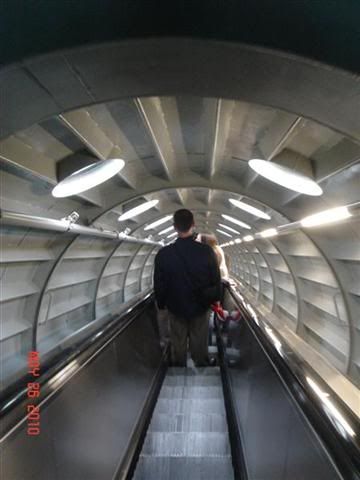
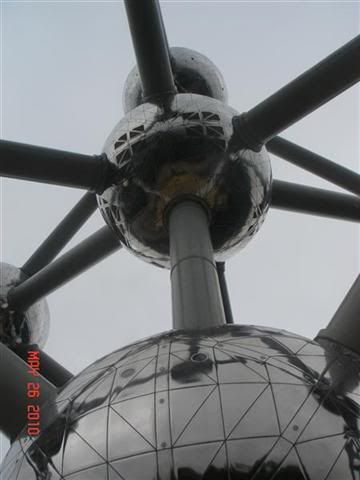
(Please Click on the thumbnails for a larger image)
After we went to the Atomium we visited Mini-Europe and had fun going around looking at the miniture versions of the landmarks of Europe, apparently this is the favorite place of one of our speakers today Mr. Linus Turner.
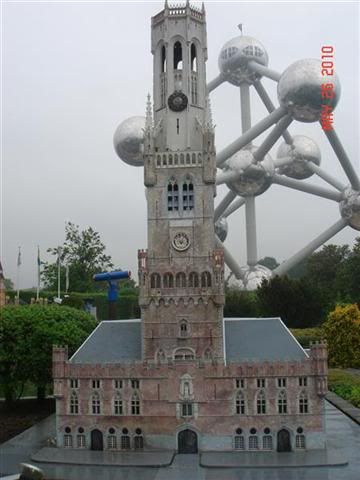
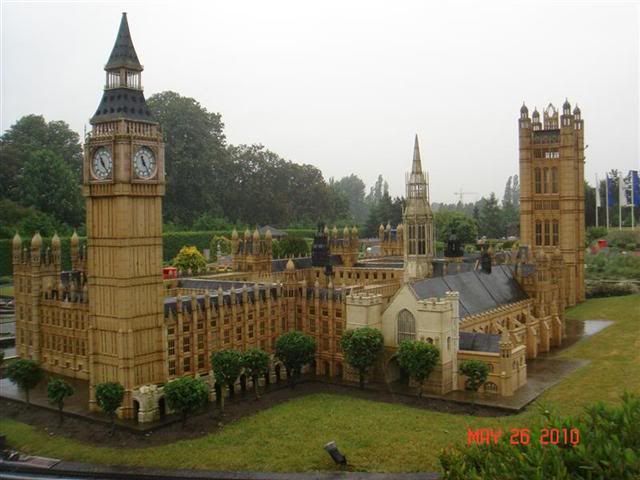
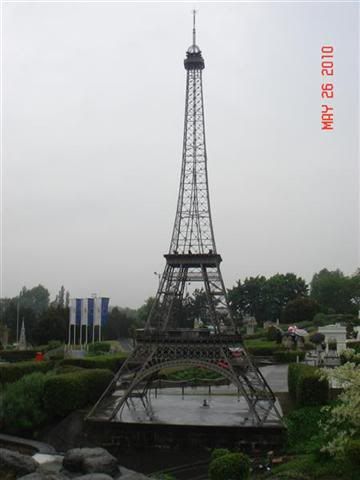
We rode the bus afterwards towards our meeting site, but before that we had our Lunch. It was a great deal, we had the Plate of the Day (Plat du Jour). It was a much needed warm meal, especially since we didn't not want to walk far in the cold, and heavy rain that we encountered after we got off the bus.
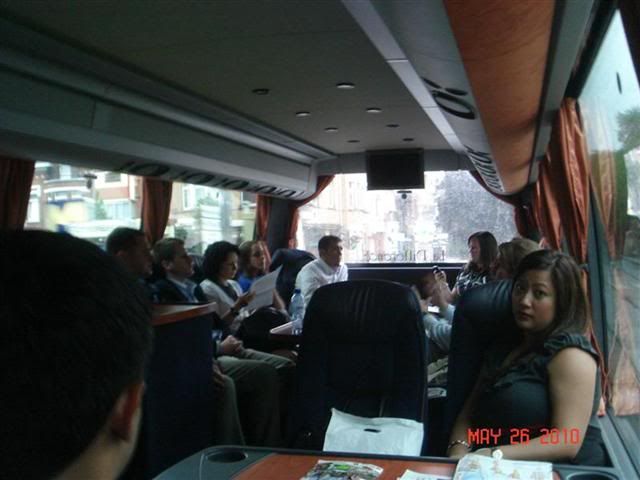
Mr. Turner was the speaker for the Brunswick group and explained to us about the lobbying system here in Europe within the European Union. Afterwards we met with Mr. Oliver Brissaud from Volkswagen Group Services.
Mr. Brissaud's presentation went into three topics, the first about Volkswagen Group Services, then about Harmonizing the EU's currencies, and finally about Derivitives. I personally found that his presentation was very amusing and that I learned a lot especially about VGS and how they operate within VW Auto Group. His explanations were very lively and animated, and allowed us to easily learn about what he was saying and trying to explain to us.
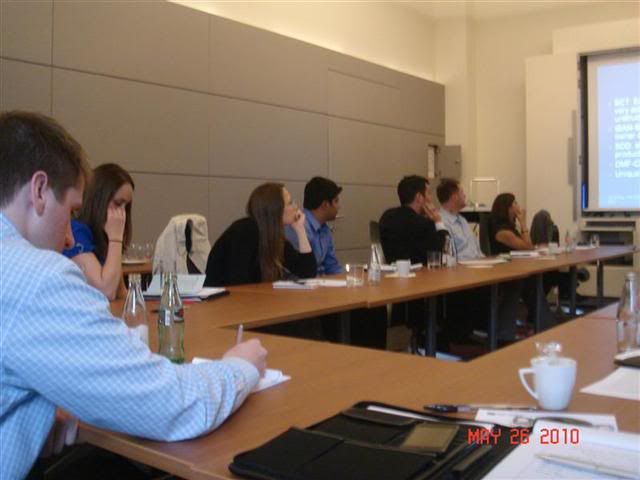
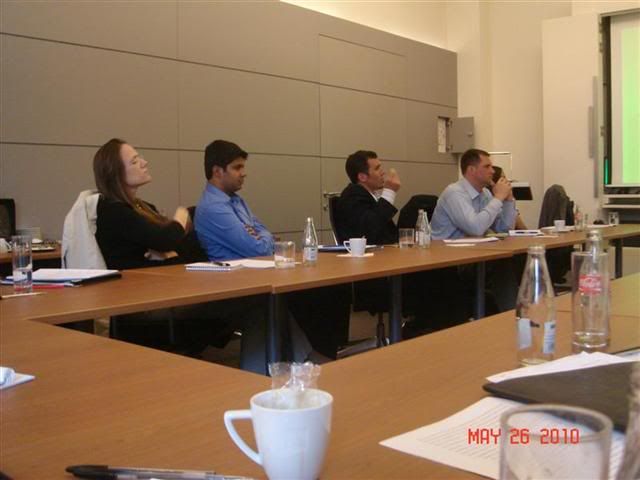
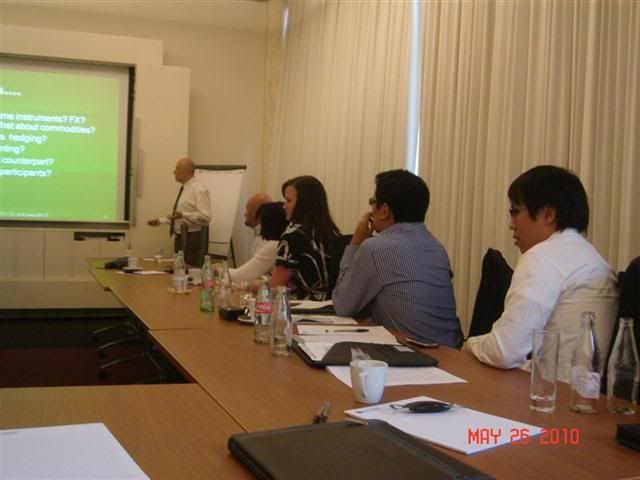
After our meeting, we were dropped off to the hotel, and a couple of classmates and I took some time to quickly explore the rest of Brussels, we were able to walk around the heart of the city within 2 hours, but this is another entry for another day. Needless to say it's been a busy day and a busy past few days, and sleep is needed to continue, but we continue to have fun, work hard, and learn a lot about Europe.
Friday, May 14, 2010
Hungry in Paris?
www.lepotdeterre.com One of their favorites..."great prices, in best area for non-touristy restaurants... off of RUE MOUFFETARD.
&
www.lecoupechou.com



